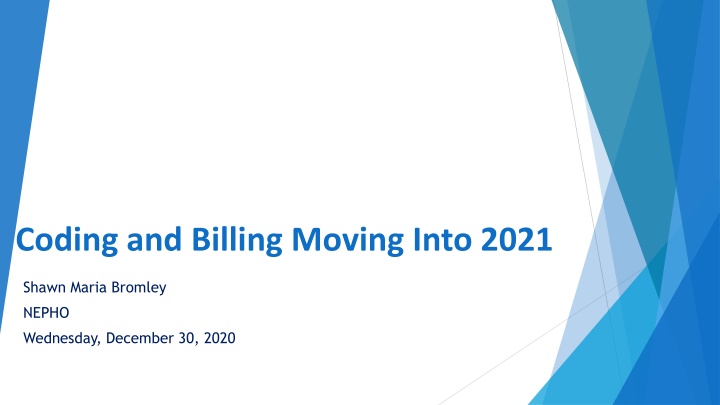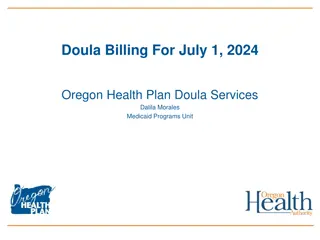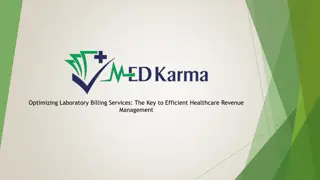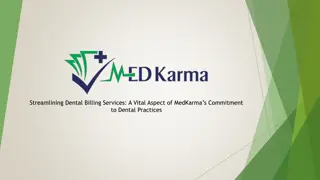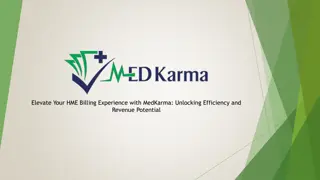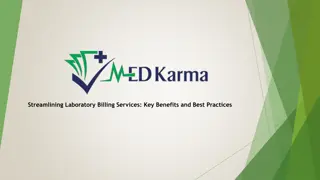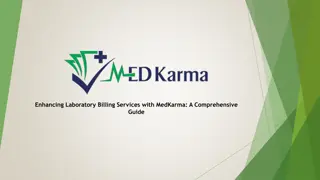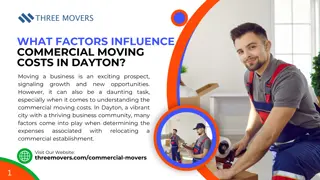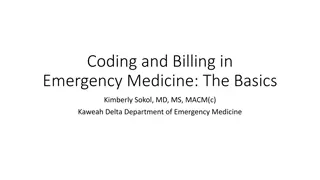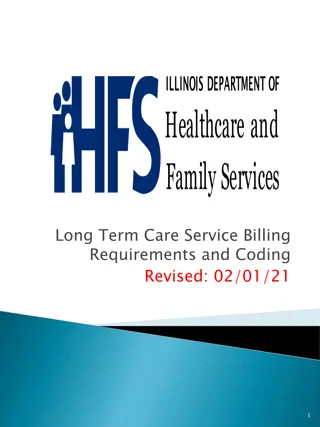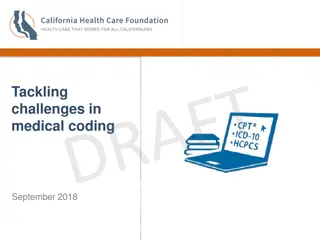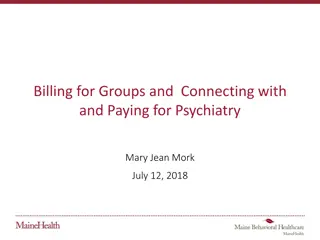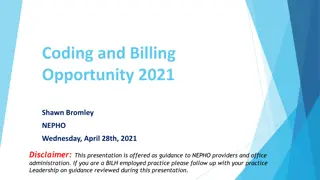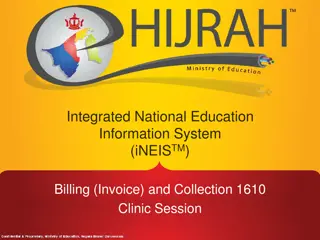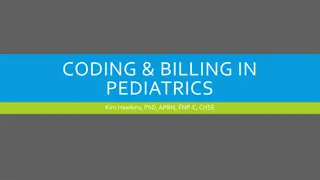Coding and Billing Moving Into 2021
As we move into 2021, stay informed about the latest changes in coding and billing practices. Explore E/M updates, time redefinition, and key components affecting medical decision making. Understand the evolving landscape of telehealth services and diagnosis coding. Prepare for resetting codes and adapting to new regulations. Stay ahead in the world of medical coding and billing.
Download Presentation

Please find below an Image/Link to download the presentation.
The content on the website is provided AS IS for your information and personal use only. It may not be sold, licensed, or shared on other websites without obtaining consent from the author.If you encounter any issues during the download, it is possible that the publisher has removed the file from their server.
You are allowed to download the files provided on this website for personal or commercial use, subject to the condition that they are used lawfully. All files are the property of their respective owners.
The content on the website is provided AS IS for your information and personal use only. It may not be sold, licensed, or shared on other websites without obtaining consent from the author.
E N D
Presentation Transcript
Coding and Billing Moving Into 2021 Shawn Maria Bromley NEPHO Wednesday, December 30, 2020
Agenda Introduction 2020 Coding & Billing Highlights 2021 E/M Updates Overview of Changes Time Leveling Medical Decision Making (MDM) Leveling Prolong Service Code Update Telehealth Review Telehealth Diagnosis Capture Review of Top 10 Diagnosis Missed for Chronic Conditions Risk Adjustment Coding Review Diagnosis Codes Reset January 1, 2021
2020 Coding & Billing Highlights COVID Coding and Billing Telehealth Services Driven by COVID 19 Additional Access to Patient Care Building a Telehealth Practice Program Staying Compliant in COVID 19 Timeframe Restrictions Being Put Back in Place ICD-10 Updates Effective October 1, 2020 Preparation for 2021 E/M Updates Risk Adjustment Coding Reset January 1, 2021
Overview of Changes Remove history and exam as key components code descriptor which requires a medically appropriate history and/or examination Code selection based on MDM or time 99201 will be deleted 99211 same requirements no components need to be met and physician presence is not required (nurse visits) 99202 & 99212 Straightforward 99203 & 99213 Low 99204 & 99214 Moderate 99205 & 99215 High
Visit Time Range Updates New Patient Codes o 99202: 15-29 minutes o 99203: 30-44 minutes o 99204: 45-59 minutes o 99205: 60-74 minutes Established Patient Codes o 99211: Outlier o 99212: 10-19 minutes o 99213: 20-29 minutes o 99214: 30-39 minutes o 99215: 40-54 minutes
Time Redefined Face-to-face time to total time spent on the day of the encounter Will help to clarify when more than one provider is involved Total time will include: o Preparing to see the patient (review of tests, prior medical visits) o Obtaining and/or reviewing separately obtained history (established patient) o Performing the medically appropriate exam and/or evaluation o Interpreting results and/or communicating results to the patient/family/caregiver o Care coordination (not separately reported)
MDM Updates Revision of MDM definitions Number and Complexity of Problems Addressed Amount and/or Complexity of Data to be Reviewed and Analyzed Risk of Complications and/or Morbidity or Mortality of Patient Management There will be a new table for calculating medical decision-making o Number of diagnosis or management options will become Number and complexity of problems addressed o Amount and/or complexity of data to be reviewed will become Amount and/or complexity of data to be reviewed and analyzed o Risk of complications and/or morbidity or mortality will become Risk of complications and/or morbidity or mortality of patient manangement
Prolong Service Code A major component of the 2021 E/M changes is the introduction of CPT prolong service code 99417(an official CPT code number will be assigned at a later date) effective January 1, 2021. The code reflects a prolonged office or other E/M service that requires at least 15 minutes or more of total time either with OR without direct patient contact on the date of the primary E/M service (either CPT codes 99205 or 99215) . CPT 99417 Code may only be reported in conjunction with 99205 or 99215 if the codes were selected based on the time alone and not medical decision making. A service of less than 15 minutes should not be reported. For example: Existing prolonged E/M code + 99354 will change to specify that you should not report the code in conjunction with 99202- 99215
Telehealth Review Follow guidelines for E/M documentation requirements Obtain patient verbal consent for audio/video visit Make sure HIPAA compliant platform is being used for the video visit Document provider performing visit location Document location of patient state/city Document all participants on the call parent, spouse, care manager Exam Vital signs heart rate, temperature, weight, general appearance Have the patient be an active participant in the exam respiratory, cardio, musculoskeletal (check movement/pain), skin (view skin on video), neuro (check gait), psych (check mood/anxiety), eyes Documenting time will help support level of service being billed I spent 25 minutes with the patient and 50% of time was spent counseling plan of care Current billing for Telehealth include: Outpatient E/M services 99211-99205 (audio/video) Audio only visits 99441 - 99443
Telehealth Documentation Examples Document plan of care for chronic conditions, condition status o Example: A Fib I48.91 heart rate within normal limits, converting back to normal sinus rhythm, apixaban is helping to regulate heart rate Chronic conditions need to be captured/recaptured annually o Example: Depression (F33.8) or depression in remission (F33.4), Opioid dependence (F11.20) or opioid dependence in remission (F11.21) (Depression: when depression has stabilized coding depression in remission would be appropriate) Chronic conditions should be discussed and documented during a new patient visit o Example: New patient visit with the following chronic conditions: Hypertension I10, CKD stage 3 N18.3, Recurrent depressive disorder F33.8, Opioid dependence in remission F11.21 Document confirmed chronic conditions to their highest specificity o Example: Diabetes with CKD stage 3: E11.22, N18.3 (1stcode diabetes with chronic kidney disease then code chronic kidney disease)
Diabetes with Complications Patient is seen for diabetes, with CKD stage 3a, the patient has type 2 diabetes and takes insulin on a daily basis Accurate coding would be: E11.22: Type 2 diabetes mellitus with diabetic CKD 3a N18.31: Chronic kidney disease, stage 3a Z79.4: Long term (current) use of insulin Patient is seen for type 2 diabetes and has hypothyroidism - Accurate coding would be: E11.69: Type 2 diabetes with other specified complications E03.9: Hypothyroidism unspecified Patient is seen for type 2 diabetes with peripheral vascular disease of the lower extremity bilateral legs with intermittent claudication- Accurate coding would be: E11.51: Type 2 diabetes with PVD I70.213: Artherosclerosis of native arteries of extremities with intermittent claudication, bilateral legs
NEPHO Coding Support Shawn Bromley @ shawn.m.bromley@lahey.org or 978-236-1704 Helpful Resources: https://emuniversity.com/ https://www.aapc.com/evaluation- management/em- coding.aspx#DefinitionofTimeforEMServiceLevels https://med.noridianmedicare.com/web/jeb/spec ialties/em
